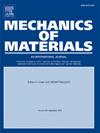On modeling fracture of soft polymers
IF 4.1
3区 材料科学
Q2 MATERIALS SCIENCE, MULTIDISCIPLINARY
引用次数: 0
Abstract
Soft polymers are ubiquitous materials in nature and as engineering materials with properties varying from rate-independent to rate-dependent. Current fracture toughness measures are non-unique for rate-dependent soft materials for varying loading profiles and specimen geometries. Works on modeling fracture in rate-dependent soft polymers are limited to specific pre-cracked geometries. There is no generally agreed-upon model for the fracture of soft polymers. We propose and show that a critical value of stress work can be used as a measure of fracture resistance in soft polymers. We develop a damage model to predict fracture in soft polymers. In the model, the energetic part of the critical stress work is proposed as a damage initiation criterion that has the ability to capture failure surfaces. The damage growth is modeled through a generalized gradient-damage framework. The fracture model is validated for both elastomers and viscous soft polymers by comparing model predictions against experimental results for different materials (ethylene propylene diene monomer — EPDM, EPS25 vitrimer, styrene butadiene rubber — SBR, and polyborosiloxane — PBS), a variety of specimen geometries, and loading conditions. The model can predict key physical phenomena such as brittle and ductile responses and different fracture profiles. The microstructural quantities, such as subchain dissociation energy during the fracture of polymers, can be predicted from the macroscopic model parameters.
软聚合物断裂建模研究
软聚合物是自然界中普遍存在的材料,也是具有从速率无关到速率相关特性的工程材料。目前的断裂韧性测量对于速率相关的软材料来说,对于不同的加载剖面和试样几何形状来说,并不是唯一的。对速率相关软聚合物的断裂建模工作仅限于特定的预裂几何形状。对于软聚合物的断裂,目前还没有一个公认的模型。我们提出并证明了应力功的临界值可以作为软聚合物抗断裂性的衡量标准。我们开发了一个损伤模型来预测软聚合物的断裂。在该模型中,临界应力功的能量部分被提出作为一种能够捕捉破坏面的损伤起裂判据。采用广义梯度损伤框架对损伤增长进行建模。通过将模型预测结果与不同材料(乙丙二烯单体EPDM、EPS25玻璃体、丁苯橡胶SBR和聚硼硅氧烷PBS)、各种试样几何形状和加载条件下的实验结果进行比较,验证了弹性体和粘性软聚合物的断裂模型。该模型可以预测脆性和韧性响应以及不同的断裂剖面等关键物理现象。从宏观模型参数可以预测聚合物断裂时的亚链解离能等微观结构量。
本文章由计算机程序翻译,如有差异,请以英文原文为准。
求助全文
约1分钟内获得全文
求助全文
来源期刊

Mechanics of Materials
工程技术-材料科学:综合
CiteScore
7.60
自引率
5.10%
发文量
243
审稿时长
46 days
期刊介绍:
Mechanics of Materials is a forum for original scientific research on the flow, fracture, and general constitutive behavior of geophysical, geotechnical and technological materials, with balanced coverage of advanced technological and natural materials, with balanced coverage of theoretical, experimental, and field investigations. Of special concern are macroscopic predictions based on microscopic models, identification of microscopic structures from limited overall macroscopic data, experimental and field results that lead to fundamental understanding of the behavior of materials, and coordinated experimental and analytical investigations that culminate in theories with predictive quality.
 求助内容:
求助内容: 应助结果提醒方式:
应助结果提醒方式:


